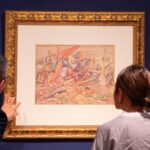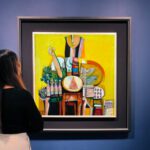Thanks to the staggering $69 million sale of Beeple’s ‘Everydays—The First 5000 Days’ at auction, NFT has become a buzzword among netizens, artists, and collectors alike. You might have even noticed your more tech-savvy friends casually drop the term into your conversations in these past few months! Following the historic first-ever digital art sale by an international auction house, NFTs have since made waves throughout the entire art world, bringing age-old debates such as “Who determines the value of art” back to the forefront.
But, what exactly are NFTs?
NFTs, short for Non-Fungible Token (isn’t that a mouthful!), is a type of cryptocurrency similar to Bitcoin. Non-Fungible is the keyword here. In essence, it just means that unlike Bitcoin, every single NFT is one-of-a-kind— if one were to trade an NFT for another, they would end up with a completely different thing. Yes, even if it was an NFT of the same digital image! It’s this inherent non-fungibility that often determines the value of the NFT. It works in the same way that dozens of people can say that they own a digital art print, but only one collector can say they have the actual painting.
Alright, but how do I know who owns the original work of art?
Well, that’s part of the beauty of NFTs! All its data, which includes a record of ownership, is safely stored in what is called a blockchain. This blockchain is comparable to a shiny Certificate of Authenticity— undeniable proof that the work of art is an original and the only one in existence. Not only that, but blockchains are immensely difficult to tamper with, which is meant to protect both the NFT’s owner and its creator in the process.
This cryptocurrency is redefining long held definitions of art, and sparking heated debates left and right within the art community. Why? It has everything to do with what can be turned into an NFT, commodified, and sold to the highest bidder. Because of its accessibility and sudden rise in market value, everyone and their mother is interested in getting their hands on this novel form of investment.
That said, NFTs are not art-specific. The format of this cryptocurrency enables it to store information such as gifs, videos, and other digital formats. In fact, the possibilities of what can be turned into NFTs are virtually limitless— so long as one has a stable internet connection and a hard drive with the capacity to “mine” this cryptocurrency.
Since Beeple’s record-breaking sale, more curious internet-artifacts-turned-NFTs have been sold off at astronomical values. Take for example the sale of Twitter founder, Jack Dorsey’s very first tweet! Despite containing just five words, “just setting up my twttr”, the simple tweet was immortalized on a blockchain and sold— garnering a ridiculous final price of just a little below $3 million dollars.
Remember Nyan Cat? Yes, the same one that was popular during the Tumblr age of the internet, aka the early 2010s. This classic meme has gone through a revival as an NFT, selling for over half a million US dollars early this year.
This puts the value of NFTs as art in an obscure gray area, at least from the perspective of collectors, that is. The trend surrounding this new cryptocurrency is frankly much too recent and volatile to accurately predict. All one can say with absolute certainty is that, much like any other speculative asset, there are certain risks taken when purchasing NFTs.
Consider the following pros and cons about NFTs.
PROS:
1. All its information is stored on the irrefutable blockchain.
As any art collector knows, an important part of an artwork’s story is its provenance. Problem is, there are times when the question of provenance gets complicated— throughout time, documents are lost or the story is jumbled up. With NFTs, however, all its history is forever recorded on the blockchain and can be easily referenced at any given time.
2. We’re in the midst of the first wave of this digital art boom.
NFTs are the new “it product”, one might say. Since NFTs, again, unlike other cryptocurrencies, can hold a digital image— it provides immediate historical context to the present. One could think of them as the pop-cultures gems of the stock market. As such, those who purchase NFTs now may presumably be able to reap the benefits of their investment in the future.
3. It provides a new platform for artists.
Any artist can turn their work into NFTs through certain websites in order to “mint” them, “mine” them, and ultimately, prepare them for sale. This opens up new opportunities for digital artists and a wide range of potential buyers through the magic of social media. You never quite know which NFT is going to skyrocket next.
Now, here are some of the CONS:
1. Some artists have reported that their work is being uploaded and sold without their permission.
As mentioned, anyone with the required bandwidth and hard drive capacity can create an NFT. With its sudden popularity and hefty price tag, some users are looking to make a quick buck— going as far as stealing work from artists and reaping all the benefits.
2. The process of “mining” has a seriously negative impact on the environment.
“Mining” has been mentioned in the earlier parts of this article, but at its core, it simply refers to the process in which a digital file is transformed into an NFT— this requires a large energy output from one’s computer. French artist Joanie Lemercier recently told the New York Times: “It turns out my release of six crypto-artworks consumed in 10 seconds more electricity than the entire studio over the past two years.”
3. There’s no certainty to this investment.
NFTs are immensely popular now. But unlike traditional fine art, which for certain artists has a proven and enduring record of acquiring value over time, there’s no assurance that you can reap the benefits of your NFT investment in the future.
With all these in mind, what do you think about the rise of NFTs? Do you think the Philippine art market is ready for this form of cryptocurrency?
In terms of its effects on the landscape of the art world in the future, nothing is quite set in stone. Yet. Though, following Beeple’s successful sale at auction, NFTs may just make it into the new normal of art sales worldwide.











